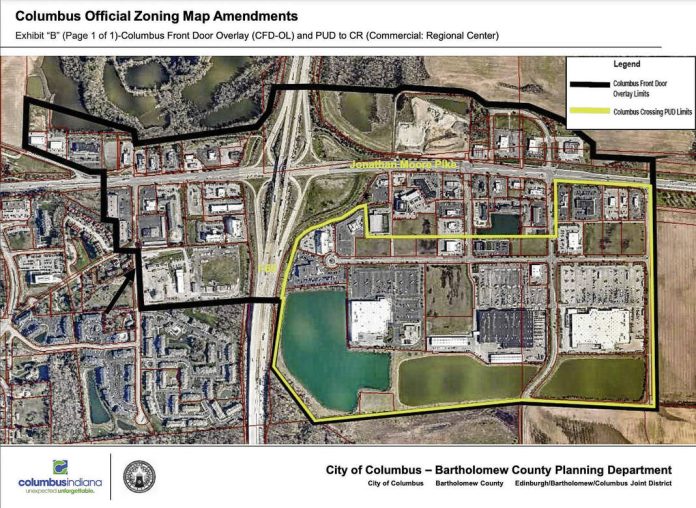
Photo provided An overview of the expanded area included for proposed new regulations regarding new development on the city’s west side
City officials next month will consider amendments to the zoning ordinance that will create a new zoning district on the west side.
The idea of the amendments would be to provide future development at Columbus’ I-65 front door with a consistent set of architectural design guidelines to ensure “cohesive development,” according to the city.
The Columbus Plan Commission on May 8 will consider three amendments: one to create a new “Columbus Front Door Overlay Zoning District,” another to include properties near the I-65 and Jonathan Moore Pike intersection in the new district and a third to rezone Columbus Crossing from PUD (Planned Unit Development) to CR (Commercial: Regional Center).
The proposed amendments won’t require any changes to existing buildings, but will apply to property that is vacant or that will develop in the future, according to the planning department.
The May 8 meeting will be at 4 p.m. in the Columbus City Hall council chambers. The public will have the chance to express views on the proposal. Questions can also be directed to Senior Planner Jessie Boshell at 812-376-2550 or [email protected].
Boshell told The Republic ensuring cohesive development at a city’s front door is a means of making a good first impression, but also helps attract future investment.
“By cohesive, we are not encouraging that all buildings look the same, the intent is that the guidelines are used to develop nice looking unique buildings that can attract tenants and new businesses into the area,” Boshell said. “… Because developers are going to locate next to things that draw people/customers in; and if developments are an eyesore, they could potentially cause for other development prospects to look elsewhere.”
The Columbus Crossing Planning Unit Development (PUD) was created in 2003 to provide a framework and basic architectural design guidelines for the development of the Menard’s and surrounding properties.
A PUD is a custom set of zoning regulations that are negotiated on a case-by-case basis between a developer and the city for new, unique development projects. City officials back then deemed the character of the area important to creating a quality “front door” gateway into Columbus.
“While the intent of the PUD was to try achieve the idea of the front door, the PUD in itself has created more complexities and inequities in development that are not needed,” Boshell said.
Businesses in Columbus Crossing subject to the 2003 guidelines include Sam’s Club, Walmart, Texas Roadhouse, Belle Tire and McAlister’s Deli. Other properties at the interchange, outside of Columbus Crossing, are already zoned as CR (Commercial: Regional).
When asked if there is an expectation in the short term that more development is likely to occur in the area, Boshell said that depends on private land owners and market motivations, but the opportunity is there.
“There are many parcels that are vacant and redevelopment opportunities, but we do not know timelines of development for those parcels,” Boshell said. “As such, the intent of the creation of the front door overlay is to be proactive, rather than reactive to development.”
The proposed new overlay district is based on and intended to replace the Columbus Crossing PUD, according to the city.
“We were intentional in how we determined the limits of the overlay district zone by determining how far to the east and west we really needed to go,” Boshell said. “As such, we decided on beginning the overlay on the west side, just east of Goeller Blvd to Morgan Willow Trace.”
“These are areas that have seen development activity over the years, but also have potential for redevelopment in the future due to their prime locations near I-65, which is prime real estate for commercial development, hotel development, and other regional uses.”
Topics addressed by the guidelines include building facade materials and features, roof top mechanical equipment, downspouts, building orientation, screening signs, and accessory/incidental structures.
“Currently, the only properties that have required any site development approval, which includes architecture, site, and building material approval have been properties within the Columbus Crossing PUD,” Boshell said. “We have been fortunate thus far that properties outside of the PUD have utilized nice corporate architecture that utilizes the standards that are being proposed.”
The plan commission’s role is to make a recommendation on the proposed amendments to the Columbus City Council, which makes the final decision.
The proposed recommendations to be considered by the commission and supporting maps will be posted on the city’s Planning Department website by May 2.




